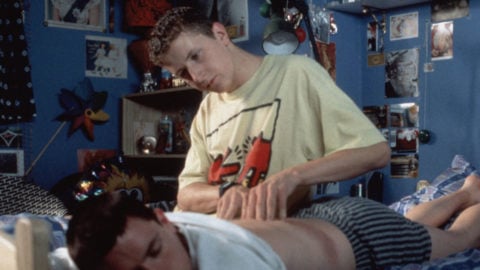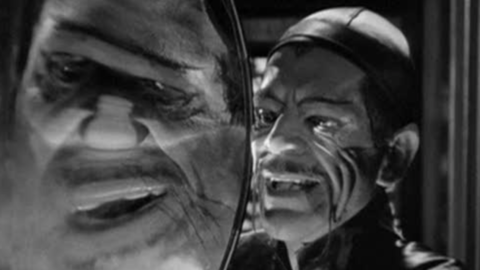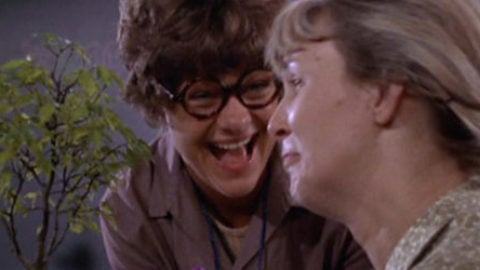Queer & Now & Then: 1982
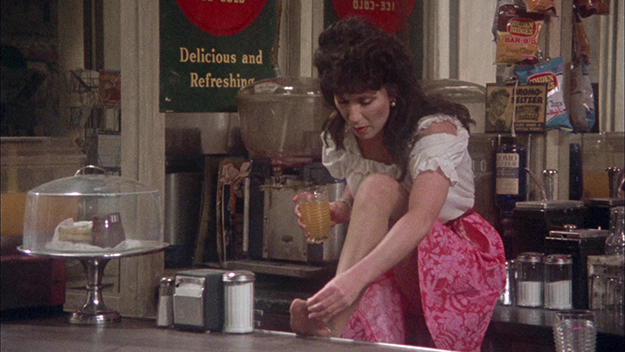
Unlike the cinema, the theater has long been a queer safe space. So it’s unsurprising, perhaps, that a majority of the most sympathetic queer films from the mid- to late 20th century originated on the stage. However primitive aspects of them may seem from our ostensibly more enlightened vantage point in 2018, such plays-turned-movies as The Children’s Hour, Tea and Sympathy, The Boys in the Band, and The Dresser (leaving aside the repressed queers of Tennessee Williams for now) all risked alienating the mainstream in ways that most films do not, simply by virtue of having gay characters in central roles. Theater purports to offer a more heightened sense of unvarnished, uncut psychological truth and honesty. In communion with the audience, the actor seeks a form of emotional realism that requires empathy. One could say that a side effect of this is that queerness, when utilized, often becomes a dramatic catalyst, part of the spark that sets off the theatrical experience, and also all too frequently a device.
This need for empathy mixed with a tendency toward excavating social issues often means that such works have often framed queerness in terms of victimhood. This tradition is based on an emotional rather than intellectual effect and an expectation of catharsis through identification, and it can be witnessed in pure form in all of the works mentioned above. This is also visible, yet given a twist, in a highly unusual case: Ed Graczyk’s 1976 play Come Back to the Five and Dime, Jimmy Dean, Jimmy Dean, directed for both stage and screen by Robert Altman in 1982. Set in a modest variety store in a small Texas town, with a timeline that toggles between 1955 and 1975, Graczyk’s play is a seemingly endless pile-up of presumably electrifying revelations and emotional confrontations among a group of female friends, ping-ponging off one another with increasingly violent force. The women, who in 1955 were part of a fan club called the Disciples of James Dean, have reunited 20 years later on the anniversary of the icon’s death, an event that dredges up memories and resentments.
There’s enough here for a half-dozen soap operas: asthmatic Mona (played on screen by the great, thrillingly erratic Sandy Dennis) claims to have slept with Dean when he was in nearby Marfa shooting Giant, resulting in her mentally handicapped bastard son; sassy Sissy (Cher, in her dramatic breakthrough) uses her sensuality and free-spiritedness to hide the fact that she had a secret double mastectomy following a battle with breast cancer; Bible-thumping fundamentalist Juanita (Sudie Bond) refuses to come to terms with her dead husband’s alcoholism and violent nature. More peripheral are pregnant, milquetoast Edna Louise (Marta Heflin), who’s always being sadly forgotten; and cowboy-hatted firecracker Stella Mae (Kathy Bates), who’s recently married into an oil baron’s millions. But the most central—and narratively destabilizing—player in this drama is Joanne (Karen Black), a stranger who shows up at the reunion, and looks oddly familiar; it is finally revealed that Joanne was once Joe, the sweet, effeminate boy who used to work with them in the shop years earlier before being cast out by the bigoted Juanita and her husband. She has returned, harboring anger but also embodying a heretofore unseen confidence, insisting she’s a she to anyone who might doubt or question her true self.
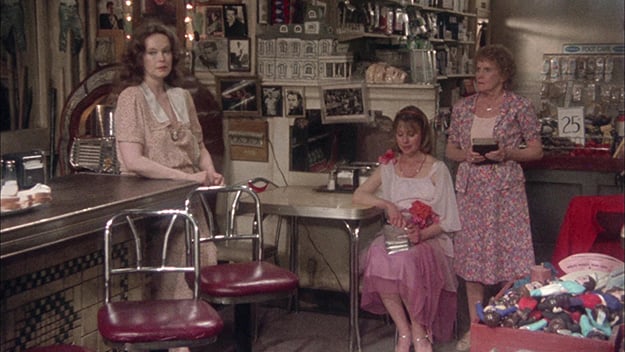
In adapting Graczyk’s play to the screen, then, Altman helped create a landmark character for mainstream film: an emotionally complex transgender woman. By 1982, historically, transgender people were classified as mentally ill, if acknowledged at all; the term “gender identity disorder” first appeared in the DSM-III (Diagnostic and Statistical Manual of Mental Disorders) in 1980—incidentally the same year that Dressed to Kill, Brian De Palma’s more clinically curious Psycho riff about a “transsexual” murderer, was released. That satirical thriller’s villainous Bobbi functioned as a figure of shock, but Come Back to the Five and Dime’s Joanne, also disruptive, is perhaps even more cinematically unusual. Her presence is indeed as a catalyst, inciting soul-searching among the women, but, as embodied by a never sturdier Black, Joanne also registers boldly as her own person; she radiates a strength that feels especially earned considering that her younger self, played by Mark Patton, was the image of insecure, fey fragility. Though the play was written more than 40 years ago, it would be too simple to say that it’s stuck in an earlier mindset; the varied responses the women have to Joanne’s return don’t feel too terribly different from what one might expect today in such a milieu. Sissy and Stella Mae are downright tickled by her transformation, hugging and showing support, though their delight sometimes crosses over to objectification (“I’ve seen things like you on TV,” exclaims Stella Mae); fundamentalist Juanita is predictably repulsed; Mona, who had once been Joe’s fiercest protector, has the most complicated response, claiming that seeing Joanne makes her “sick to her stomach,” although as more revelations come out, it’s clear this is not simply a response to Joanne’s corrected gender.
Despite occasional idiotic accusations over the years of Altman “judging” his characters, his endless curiosity about people’s lives, religions, professions, and regional idiosyncrasies made him one of American cinema’s most compassionate directors. He gave actors the space to create and burrow. His love for Graczyk’s tough, tender, brittle women comes through despite the fact that he once said, “I didn’t think it was a great play. I didn’t like the writer very much.” Some have considered Come Back to the Five and Dime something of a theatrical freak show, and while this male playwright’s rendition of female friendships perhaps all too often devolves into the kinds of histrionics that so often give theater a bad name, the case can’t be plausibly made that Joanne is made grotesque. In fact, she’s framed as the wisest of the bunch, something like a becalmed truth-teller who has attained a level of self-knowledge that allows her to see the world more clearly than the other women. “Unlike all of you, I have undergone a change,” she says in the most cutting line; and she saves her most benevolent words for the eternally ignored sad-sack Edna: “You glow brighter than anybody in the place.” With her gloved hands, death-stare sunglasses, and teased hair, Karen Black enters the shop as a glam phantom, ethereally browsing as she bides time before figuring out how to identify herself to the friends she hasn’t seen in decades. As Joe, she was an outcast, unable to partake in the trappings of femininity, and regarded with disgust and suspicion by Juanita for his transgressions, such as daring to lip-sync and dance with Mona and Sissy to the McGuire Sisters. Juanita had encouraged her husband’s firing of the boy (not for anything he did, but for being “what he is,” she matter-of-factly admits) and, by turning her back on him in a time of need, all but condoned his beating and rape at the hands of the town bully.
Post gender reassignment surgery, Joanne dredges up the women’s own insecurities. This is true not only for Mona and Juanita, but also for the initially enthusiastic Sissy, whose loathing of the altered state of her own post-op body is just one of the many conceptually overdetermined mirror images that abounds in Graczyk’s script, and which is heightened by Altman’s staging. The director, coming off his richest, most daring decade of filmmaking, had momentarily turned to theater at the beginning of the ’80s. He began shooting the film of Come Back to the Five and Dime just one week after the last of the play’s 52 Broadway performances, starring the same cast. It was a cheap production, made for under a million, shot on super 16mm on two adjacent sets in a Manhattan studio. The sets were built as mirror images of each other, one for the past and one for the present, so the roving camera could follow the actors between time periods in single takes, and Altman could zoom and track and use superimpositions, lighting, and mirror effects to collapse time in-camera. The film sometimes feels like a cheaper, more visually economical variation on Coppola’s elaborately set-designed One from the Heart, made the same year, but it finds parallels in Altman’s own Images (1972) and 3 Women (1977), also films specifically about women that traffic in dreams and doubling.
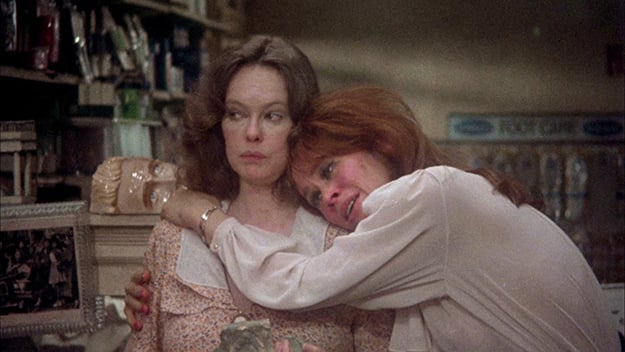
Altman makes no effort to hide the fact that this is still, in essence, a play; for a film “stage-bound” is often employed as a derisive term, yet Altman all but imposes Come Back to the Five and Dime’s theatrical origins onscreen. Its reflective surfaces and tightly circumscribed boundaries speak eloquently to the work’s thematic battle between the political naïveté and economic hope of the ’50s and the social and political disillusionment of the ’70s (a topic of which Altman was one of the great American artists), but it also grants the film an indefinable, eerie physical and emotional effect. The set feels bare and creaky, and the sound design doesn’t do much to mask that; when Sandy Dennis raises her voice, you can hear it echoing as though she’s screaming at a barren stage. Reminding the viewer they’re watching a theater piece helps reaffirm Come Back’s essential queerness, creating a protective, non-filmic layer around Joanne in a medium that has mistreated trans and queer people throughout its history. “In the eyes of God, he does not belong,” Juanita shrieks at one point. Mona’s response—“Then God is wrong!”—is a righteous, melodramatic wail made for the stage, but which, in Altman’s film, pierces the screen.
Michael Koresky is the Director of Editorial and Creative Strategy at Film Society of Lincoln Center; the co-founder and co-editor of Reverse Shot; a frequent contributor to the Criterion Collection; and the author of the book Terence Davies, published by University of Illinois Press.



